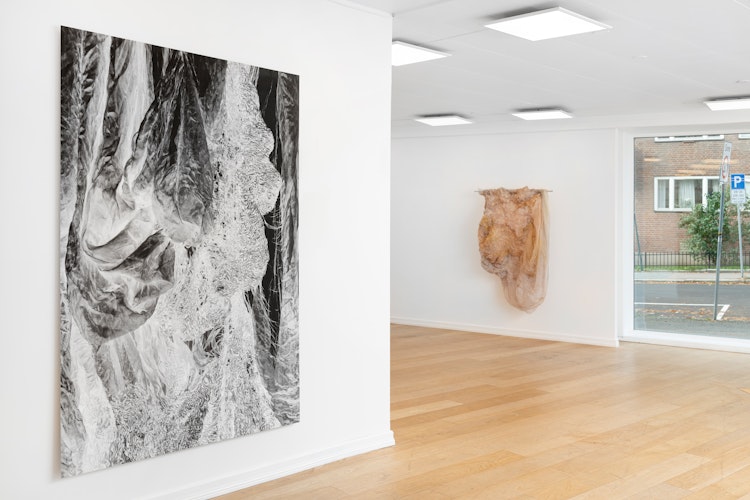Translucency


The textiles seem to breathe. In the hands of Hanne Friis, metres upon metres of handdyed nylon organza is sewn into a terrain of tension between softness and gravity, body and landscape. It is a process of presence and a matter of transparency.
There is something corporeal in Friis’s sculptures — a sense of body made visible through folds and bulges that hint at skin, flesh, and viscera, yet never portray them outright. Her forms seem to hover between the microscopic and the monumental: a lung, a mountain, a wave, a wound — or perhaps a geological formation slowly coming into being. Through a slow, meditative process of thousands of hand-stitches, she transforms organza into a sculptural field of reflection and presence. Open weaves and translucent layers expose both material depth and void, balancing strength and fragility.
The shimmering surfaces of the textiles create a play of layers and transparency, not unlike the vibrating tones of color in painting. Rooted in both painting and sculpture, Friis’s practice unfolds in a space between the abstract and the organic — where matter seems to transform before our eyes.
There is a quiet resistance within the works, subtle disturbances where fields open and contract, where a plane of color suddenly pushes outward. The soft, tactile surfaces and the visible traces of gravity are deliberate gestures, inviting a bodily connection to the pieces. Between the folds, small intervals appear — like pockets and tunnels of light where the textile loosens its grip. These openings are not empty, but vital spaces where the work breathes, balancing weight and lightness.
In art history, sculpture is often associated with the heaviness and permanence of bronze, ceramics or marble. Friis turns this upside down and builds weight from softness and monumentality from fragility. There is nothing static about the textiles either—only a liberating sense of potential, of movement that continues, of life unfolding. For this exhibition, however, she introduces a series of photographs that suspend a single detail, a quiet pause in the act of observing a work. Like an X-ray of the inner self, they draw us close—so close that we find ourselves within the very weave of the fibers, where the word translucency takes on a deeper, more luminous meaning.
When Friis lets the behavior of materials — weight, gravity, and tension — determine the final form, her approach echoes that of the American-German artist Eva Hesse (1936–1970), who in the 1960s explored similar ideas through her fiber and latex sculptures. Hesse worked in the space between minimalism and abstract expressionism, creating sensuous, permeable, and mutable installations that evoke reflection on the transience of all things and on fragility as a fundamental aspect of being human. With Translucency, Hanne Friis likewise opens up such a space of contemplation. Both artists succeed in transforming industrially produced materials — in Hanne Friis’s case, nylon organza — into something that conveys a fragility and sensuality that is both pervasive and insistent. In the work of Hanne Friis, every seam holds the trace of a decision. And between the folds, there are spaces — voids, pauses — where the work exhales.
Text by Henriette Noermark







What are you looking for?